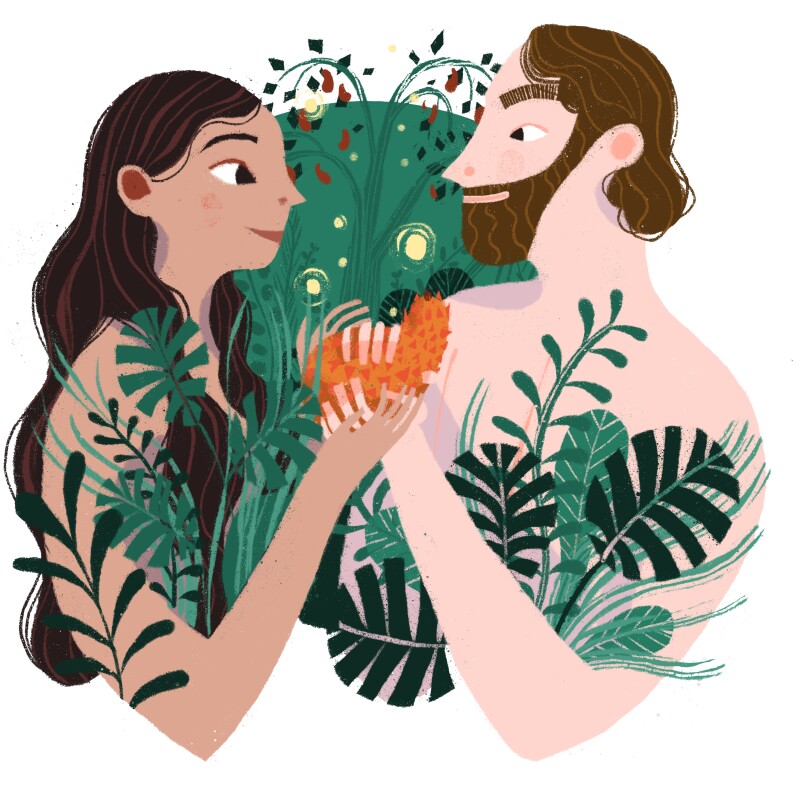As a curious, inquisitive child, I dreamed of being a detective. Alfred Hitchcock’s Three Investigators chapter books set my young imagination on fire. I looked everywhere for mysteries to solve. As I grew up, however, I turned my focus to other pursuits and gradually stopped searching.
But some mysteries find you. It’s as if they linger in the shadows until one day you discover they’ve been there all along, waiting for you to notice and get involved.
That’s how I felt as a 40-something adult when I realized what a wide gulf there was between our heavenly parents’ plan for their beloved daughters and the actual lived experiences of so many. If I understood the great plan of happiness (and I believed I did), why were so many women experiencing such a great degree of suffering? My nonprofit work with various organizations that focused on supporting and empowering women revealed “infuriating unfairness”1 everywhere I looked. I felt consumed by the need to at least reconcile, if not resolve, those gross discrepancies.
I decided to start at the beginning, searching for the truth about Eve. I got busy asking questions. Among the wide range of views offered up by writers, scholars, and pundits, I found two categorical perspectives that seem to inform most people’s understanding of our first parents’ story. We could call them the traditional worldview and the restored gospel view.
The traditional worldview generally focuses on a few key events—like touchpoints on a timeline. Proponents of this perspective can tick off those moments on the fingers of one hand: Adam lived in a lovely garden, God made Eve from his rib, a sneaky snake came along, Eve made a serious mistake, and they both got cast out. Straightforward. And tragic.
A look at women’s history will demonstrate that the traditional worldview of this story leads so easily to both misunderstanding and misapplication. For example, Camille Fronk Olson, former chair of Brigham Young University’s Department of Ancient Scripture, observed, “Although divinely designated to be a heroine and role model for her daughters, Eve is one of the most misunderstood women in history.”2
In an official declaration to the Parliament of the World’s Religions, former US president Jimmy Carter pleaded for a closer look at how women have historically been regarded, in large part because of misunderstandings related to the biblical account of our first parents. He explained that “this discrimination, unjustifiably attributed to a Higher Authority, has provided a reason or excuse for the deprivation of women’s equal rights across the world for centuries.”3 And he took his insights one bold step further, declaring that this confused interpretation of Eve and Adam’s story has damaged all of us.
So, let’s examine what the restored gospel view clarifies and the difference that clearer view makes.
If the traditional worldview fixates on points on a timeline, we could say the restored gospel view cares more about the intervals—the befores, the betweens, and the afters of Adam and Eve’s story. This perspective, in conjunction with additional information from Restoration scriptures and prophetic teachings, reveals at least one crucial omission from the traditional worldview: Jesus Christ. Our Savior has been present and involved in every one of those intervals. And He changes everything.
Let’s label and look at those intervals. His presence in each illustrates the purposeful pathway of exaltation. Eternal life was never intended to be solely a finish line event but rather a process we choose to participate in, step by step, throughout our journey home.
Premortality
In 1842, the Prophet Joseph learned through revelation that “the King, Immanuel” had “ordained, before the world was, that which would enable” our redemption.4 Or, in the words of Tad R. Callister, “The Atonement commenced when the Savior made that selfless offer in the premortal council, ‘Here am I, send me,’ and continues without end as he ‘bring[s] to pass the immortality and eternal life of man.’”5
Immanuel is an ideal title for Jehovah in this premortal setting. Meaning “God with us,” it is a lovely reminder that He has been with us and for us since our earliest realm. We knew and loved Him enough to trust Him from the start. This empowering doctrine can fuel our faithful courage along each step of our journey, just as it must have motivated Adam and Eve as they prepared to come to Earth and enter the garden.
Partnership

Though various figurative elements are employed in Eve’s introduction to Adam, there are also two literal details in this part of their story that highlight Christ’s redeeming role: She is introduced as Adam’s help meet.6 This oft-misunderstood term has caused harm as it has led some women to feel “less than” their male counterparts as if they are intended to be subservient assistants. But in reality, “help” is derived from the Hebrew word ’ezer, which means “to rescue” or “to save.” Elsewhere in the Old Testament, this term refers almost exclusively to the kind of help the Lord gives—divine help.7 Likewise, Eve’s Hebrew name, Chavvah, means “Life,” symbolic of the Savior, who is “the light and the life of the world.”8
What a difference these linguistic details make in our understanding of Eve! Just as we would never consider God to be a subordinate assistant, Eve was a crucial counterpart to Adam; only together could they successfully progress and ultimately become like and return to our heavenly parents.
Tutoring

Once united in the garden, Eve and Adam enjoyed an unspecified interim of divine tutoring. The late Elder Mark E. Petersen taught that Adam and Eve “were well educated, having been taught by the Lord himself. . . . That task [of tutoring our first parents] was left to the Lord and his angels.”9
Our first parents’ understanding of the gospel of Jesus Christ, though more theoretical than practical at that stage, was a necessary ingredient for the exercise of their agency in choosing to leave the garden.10 Since knowledge is a prerequisite of accountability, this period of learning was essential.
Decisions
Eve’s and Adam’s decisions to partake of the fateful fruit, though nudged to some degree by the uncertainty introduced by Lucifer, marked their deliberate choices to cross the threshold into mortality and initiate the next segment of the plan of salvation.

As President Russell M. Nelson has so powerfully taught, “It was our glorious Mother Eve—with her far-reaching vision of our Heavenly Father’s plan—who initiated what we call ‘the Fall.’ Her wise and courageous choice and Adam’s supporting decision moved God’s plan of happiness forward. They made it possible for each of us to come to Earth, receive a body, and prove that we would choose to stand up for Jesus Christ now, just as we did premortally.”11
What a major departure this fundamental doctrine is from the traditional worldview of Eve. Recognizing her faithful courage in Christ’s atoning sacrifice changes one’s opinion of her action from a shameful misstep to a supreme gift to mankind.12 The far-reaching impact of this understanding surely cannot be overstated.
Preparation

Following their decisions to partake, Adam and Eve were empowered by a final period of tender preparation.13 While the precautions and warnings of what earth life would hold for them were certainly valuable, the gift of lovingly prepared coats was imperative. These practical reminders, personally crafted by Christ, symbolized the power and protection available to them through His infinite atonement.
Wrapped in His warmth, they were ready. Julian of Norwich, a religious 14th-century English author, described the value of those sacred coats, for both them and us, when she wrote, “He is to us everything that is good and comfortable. . . . He is our clothing that for love wrappeth us, claspeth us, and all encloseth us for tender love, that He may never leave us.”14 Though Adam and Eve would now leave divinity’s immediate presence, in a very tangible way, Christ would leave with them.
Mortality
Moses 5:1–15 is truly a pearl of great price when it comes to understanding Adam and Eve’s early days of mortality. These precious verses, absent from the Genesis account, illustrate how carefully they collaborated, with each other and with Deity, as they embarked on their brave adventure.

Even from a distance, they sought and heard the Lord’s voice. As Callister has explained, “To be shut out from the presence of God was not to lose all communication with him; that would defeat the plan of salvation. Rather, it was to be cast out from his physical presence, leaving all other forms of communication open.”15 That communication included Christ’s hope-filled testimonial in Moses 5:9: “I am the Only Begotten of the Father from the beginning, henceforth and forever, that as thou hast fallen thou mayest be redeemed, and all mankind, even as many as will.”
What was true for Eve and Adam is true for each of us: Christ was, is, and always will be our Redeemer and Savior. Mortality is full of mysteries, but His presence—His loving, watchful care—is not one of them. The whole point of scripture—including Adam and Eve’s story, both Old and New Testaments, and all of Restoration scripture—is to provide evidence of His involvement in our lives. As we read in Psalm 46:1, “God is our refuge and strength, a very present help in struggle.”
Once you can see Him throughout Eve and Adam’s story, then the next question is, Do you see Him in your story? Because when you do, His presence changes everything. Elder Dieter F. Uchtdorf described this so beautifully when he said, “The Savior’s infinite Atonement completely changes the way we may view our transgressions and imperfections. Instead of dwelling on them and feeling irredeemable or hopeless, we can learn from them and feel hopeful. . . . God is among us—and is personally involved in our lives and actively guiding His children.”16
Christ is the great King Immanuel. As Adam and Eve experienced, Christ was with us at the beginning, He will be with us at the end, and He can be with us now—in every moment of this messy middle.
Notes
1. See Dale G. Renlund, “Infuriating Unfairness,” Liahona, May 2021, 41–42.
2. Camille Fronk Olson, Women of the Old Testament, (2009), 1.
3. Jimmy Carter, speech to the Parliament of the World’s Religions, Dec. 2, 2009, cartercenter.org.
4. Doctrine and Covenants 128:22.
5. Tad R. Callister, The Infinite Atonement (2000), 23.
6. Moses 3:18; see also Genesis 2:18; Abraham 5:14.
7. See Psalm 30:10; 54:4; and 121:1–2, for example.
8. See Moses 4:26; see also Genesis 3:20; 3 Nephi 9:18.
9. Mark E. Petersen, “Adam, the Archangel,” Ensign, Nov. 1980, 16.
10. Elder Jeffrey R. Holland wrote: “[Adam and Eve] were willing to venture [sorrow and death] only with the knowledge that there would be safety at the end of the day for those who wanted it and lived for it.” (Christ and the New Covenant [2006], 203).
11. Russell M. Nelson, “Sisters’ Participation in the Gathering of Israel,” Ensign, Nov. 2018, 68–69.
12. See Encyclopedia of Mormonism (1992), “Eve,” 2:475).
13. See Moses 4:13–30; see also Genesis 3:7–22.
14. Julian of Norwich, Revelations of Divine Love, v.
15. Infinite Atonement, 35.
16. Dieter F. Uchtdorf, “God among Us,” Liahona, May 2021, 8–9, emphasis added.



